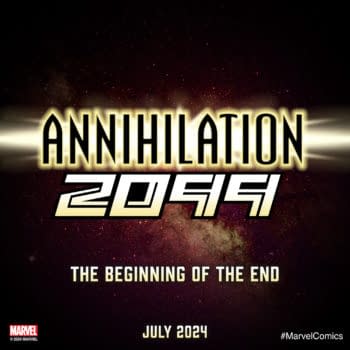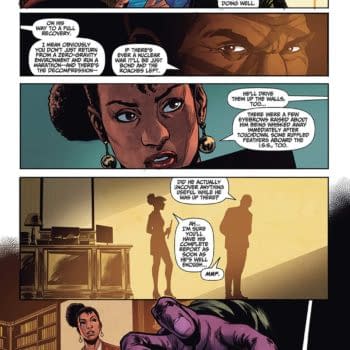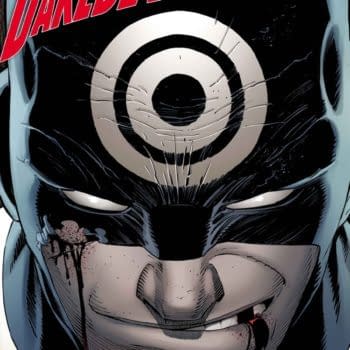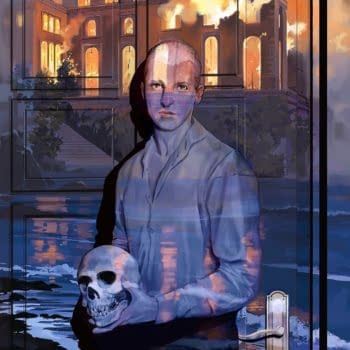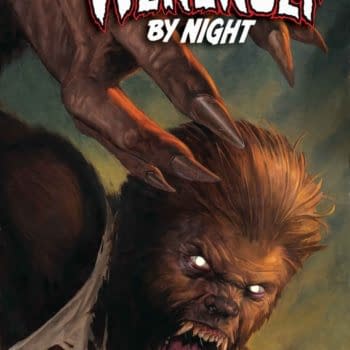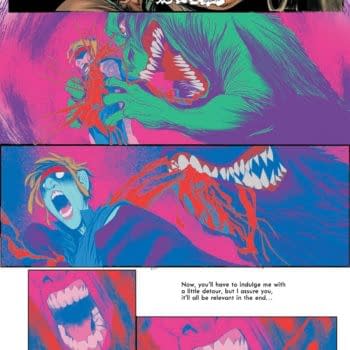Posted in: Comics, NYCC, Recent Updates | Tagged: dark horse comics, entertainment, Ethan Young, Nanjing: Burning City
Nanjing: The Burning City Tells 'A Very Dark Chapter Of WWII' – Ethan Young In The Bleeding Cool Interview
I first came across Ethan Young and his work at a live comics reading event at Housing Works in New York City a few years ago, and seeing his work projected on a large screen really emphasized the clarity and emotion of his linework and the wittiness of his dialogue, in this case themed on the experience of a first generation American dealing with the overlap in cultures, especially in family life. Cut to a couple years later, and after following his charity-driven work on an all-ages animal rescue comic A Piggy's Tale, I heard he was working on a full original graphic novel of a very different story type from his previous long-running webcomic Tales. Rather than deal with anthropomorphised animals, Young was taking on a real historical situation during the Second Sino-Japanese War (1937-8) where in Nanjing, China, an entire city was held in siege, and then captured, by Japanese forces. Young had decided to tell the story of the people within the walls during this event.
The book has now been released in hardcover from Dark Horse as Nanjing: The Burning City. And the critical reception of the book has been remarkable, with Publishers Weekly recently commenting:
Young's decision not to glorify violence or titillate the reader in any way avoids a common pitfall and heightens the drama. This is stunning, stirring historical fiction by a creator at the height of his craft.
I would have to agree. I provided a back cover quote before the book came out, saying:
Ethan Young digs deep to make a forgotten chapter of human history unforgettable. He presents chaotic events and cultural complexity with grace, and tells a story about human dignity with all the raw emotion it deserves.
The book is powerful, beautifully and terrifyingly drawn, and naturally leads me to want to talk to the creator about his choices and experiences working on the book. Ethan Young joins me here today to talk about Nanjing: The Burning City.

Ethan Young: Hey, Hannah! First off, thanks for having me, and for all the support and kind words!
An emotional truth is the perfect way to describe my storytelling process. With Nanjing, I was diving into a story with no personal experience of my own, and relied heavily on genre tropes to carry the narrative. So, emphasizing the intimate, emotional elements was key to connecting the reader to a character that is essentially a walking archetype. I asked myself, "What would I do and say if I were there right now?" Nanjing is really small in scope, it's really just about your personal investment in the journey of several characters.
HMS: In terms of subject—matter, this feels like a massive leap in a new direction for you as a comics creator and that's one reason among many that critics are so amazed and blind-sided by the significance of this graphic novel. How did you come to the subject? Were you afraid to try something so new and long-form?
EY: I was afraid in the sense that I'd really screw up. As far as I know, this is the first graphic novel to touch on the Nanjing Massacre, so if the final product felt contrived, it wasn't just my career taking a hit, but the representation of an event that deserved real respect and sincerity.
Nanjing had been cooking in my mind for almost a decade. As a child of Chinese immigrants, the Second Sino-Japanese War was a very contentious cultural touchstone for my family. I didn't grow up in China, but my mother would still spout anti-Japanese sentiments from time to time. After quitting college in 2002, I wanted Nanjing to be a statement project, but I wisely shelved it. My twenty year old self was not prepared for the demand of this book
Finishing a long and slow project like Tails – combined with years of freelancing – helped hone my skills in time to tackle Nanjing again in 2013. And to be honest, I do like the fact that some people feel like I just came out of nowhere. It's refreshing.

EY: I grappled a lot with whether or not I should even pursue it. I constantly asked myself: Is this too dark? Too biased? Too unrelatable? Ultimately, I figured that China's involvement in WWII needed a larger spotlight for the uninformed.
Personally, it was hard not to get sucked into anger. When you feel empathy for one party, such as the victims of a war crime, your most basic reaction is to lash out at the aggressors. Or worse, vilify them one-dimensionally.
But there are many gray areas, even in tragedies such as the Nanjing Massacre (the Chinese government at the time virtually sacrificed the capital). Working to separate your feelings is always hard – remembering that the actions of an army don't reflect the people of a nation.

EY: I did do a lot more thumbnails for this book to be more precise, but I always leave it very fluid. My scripts are just detailed outlines, and I handle each scene as I arrive to it, coming up with dialogue as I navigate the scene in the layout process.
As you mentioned earlier, I sent you an early hardcopy before I landed at Dark Horse. I had finished the first 60 pages in 3 months, keeping myself to a very rigorous schedule. With Tails, I was much more neurotic, and went through 2 – 3 pencil stages before inks. Near the end of Tails, I had introduced looser techniques, and used them at full force when I started Nanjing.
After a 4 month hiatus to pitch the first half of the book, Dark Horse picked it up, and my editor and I were determined to wrap up the book by early 2015 before my son arrived.
HMS: What advice would you give to someone approaching their first long-form work in a graphic novel to stay on track and reach their goal?
EY: Basically, just finish your book. I know it's easier said than done. I see a lot of aspiring folks who either have trouble sticking to a schedule, or their perfectionism drags them back to constant revisions, or they're just nervous to put their work out into the public. A lot of it is fear: fear of rejection, criticism, scrutiny, you name it.
And really, nobody will care about your first work. It sounds very cynical, but it's so true. Very few are Craig Thompson or Kate Beaton. Your first project won't be your magnum opus, as much as you'd like to prove me wrong.
Other than that, stick to a schedule at all costs. This second part is equally hard. Anyone can devise a schedule, but keeping to it seems impossible for some. It's more fun to create characters and design costumes, and much more difficult when you actually have to convey a story through hundreds upon hundreds of panels.
For that, I would suggest creating mini-goals for yourself. Finish ten pages? Buy yourself a drink. Finished thirty? Another drink. It gets easier with time and repetition, and once you combine the two points of advice here, and you accept the fact that you're not creating the Mona Lisa, you calm down and get to work. The most important thing is that the book gets finished. That way, people can actually read it.

EY: For the most part: definitely! Most reviews have done me more justice than I deserve. The fact that teachers, librarians, and general history enthusiasts have responded so well really touches me. Some have been previously aware, whereas for others, this is their first foray into a very dark chapter in WWII.
It's strange, because even though I'm pontificating about China's lack of recognition in WWII here in the US, I'm an anti-war person at heart. When you read Nanjing, and some people have touched upon this with their reviews, the book is really a statement against war, and how people are engulfed in it like a tidal wave. Larger ideas of good and evil are thrown out the window when it comes down to pure individual survival. (There are accounts of Chinese soldiers doing some not-so-admirable things to hide during the massacre) But history books don't like gray areas or ambiguity, they like clear narratives. I wanted to explore those gray areas, more than anything.

EY: The one that's really close to me is Darwin Animal Doctors, an animal hospital in the Galapagos which is co-founded by Tod Emko, creator of A Piggy's Tale, which I co-write and illustrate. Tod is doing some great work to bring humane education and veterinarian services to an area desperately in need of it. Not a lot of people know this, but ALL the profits from A Piggy's Tale (including merchandise) go directly to D.A.D. He keeps none of it for himself.
I gave Tod a big price reduction for doing the comic, and I've also put some of my own money into some of the merchandise to help raise money. (The trading cards for C2E2 were my own gamble) Plus, we just love that kids have really gravitated to this inspirational comic.

EY: Hehe… well, right now, I'm inking and coloring the first half of my next project for Dark Horse, which is a sci-fi allegory of the Ballad of Mulan. It was one of my mother's favorite folktales, and I wanted to pay tribute to it, while injecting it with some action, nuance, and politics. This is the first time that I've done everything in a book myself, so it's been a brand new challenge. It's also a YA book, so it'll have a lighter tone than Nanjing, and showcase more of the genre skills that I hinted at with Tails.
After I wrap up that book next spring, I'm officially slated to work on a one-shot with Tod starring Simon, the feline sidekick from A Piggy's Tale. It's going to be a blast, and we're thrilled to be doing it.
Also, a super secret third project that I'm brewing, but can't really discuss much. This third one is still up in the air, but will be pretty cool if and when you see it.
HMS: Thanks Ethan!
Look out for Ethan Young at New York Comic Con next week, and make sure to ask him about his work on Nanjing and upcoming projects!











